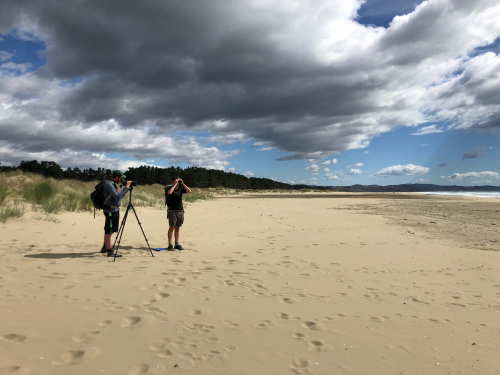
Current filter:

The Regional Council has released its first survey of Hawke’s Bay’s coastline which shows a healthy coastal bird population along 321 kilometres.
The surveying team went by foot or boat from the bottom of Hawke’s Bay’s coast at Whangaehu up to Mahanga, and recorded the presence and number of all birds and marine mammals they saw for each 1km section along the coast.
Regional Council Scientist Marine and Coasts Becky Shanahan says the survey is a great benchmark for the Regional Council and gives a clear picture of the state of Hawke’s Bay’s coastal birds.
“This is the first time we’ve surveyed our coast from the top to the bottom, and we’re really excited to see the results. Over 32,000 birds were counted over the 2021-21 summer – that’s massive!” says Ms Shanahan.
The Regional Council commissioned the survey of native birds to create a regional-scale baseline measure of the diversity, distribution and abundance of birds along the coast.
“We know that Hawke’s Bay supports a huge amount of coastal bird species along our diverse coastline. We didn’t know what the population was and where the birds were along the coast. By doing this survey, we now have population estimates and detailed distribution maps for Hawke’s Bay’s coastal bird species.”
Ecologist Nikki McArthur led the survey and says the region’s first full survey is promising.
“The Hawke’s Bay coastline is an important breeding and foraging ground for many native birds,” says Nikki.
“We counted 79 birds species, with 72% being natives. Sadly, 35% of these native birds are ranked as either nationally threatened or at risk due to habitat loss and degradation, predation, impacts from other human activities, and climate change,” says Mr McArthur.
The team surveyed 65 estuaries and lagoons showing native species thrived the most in these environments, as well as on inshore islands and along sections of coastline with mixed rocky shore and sandy beach habitats.
“Te Whanganui-a-Orotū/Ahuriri Estuary supported the highest diversity of indigenous birds with 33 species and 3,356 individuals counted.
“The Pōrangahau Estuary had the second highest number of indigenous bird species, with 24 species and 1,311 individuals, and the Maungawhio Lagoon had the third highest number of species, with 22 species and 420 individual birds.
“Some of the birds seen along the coast included Arctic-breeding and endemic shorebird species, such as bar-tailed godwit (kuaka), ruddy turnstone, banded dotterel (pohowera) and ngutu pare wrybill (ngutu pare).”
“This count showed a massive increase for in the numbers of banded dotterel (tuturuwhatu), up from 86 in 2011 to 222 this year, which is a direct result of conservation interventions through pest control and managing human disturbance. It’s rare for any part of the country to see such a strong recovery by a threatened species, and it’s so cool to see it here in Hawke’s Bay. It’s a credit to the groups that care for coastal habitats, including Department of Conservation, the Regional Council, Cape to City, and community groups,” adds Nikki.
The Regional Council will be sharing the results with the community through some hands-on workshops and invite the community to come along.
Workshops will be held on:
9 November 2021
Disclaimers and Copyright
While every endeavour has been taken by the Hawke's Bay Regional Council to ensure that the information on this website is
accurate and up to date, Hawke's Bay Regional Council shall not be liable for any loss suffered through the use, directly or indirectly, of information on this website. Information contained has been assembled in good faith.
Some of the information available in this site is from the New Zealand Public domain and supplied by relevant
government agencies. Hawke's Bay Regional Council cannot accept any liability for its accuracy or content.
Portions of the information and material on this site, including data, pages, documents, online
graphics and images are protected by copyright, unless specifically notified to the contrary. Externally sourced
information or material is copyright to the respective provider.
© Hawke's Bay Regional Council - www.hbrc.govt.nz / +64 6 835 9200 / info@hbrc.govt.nz